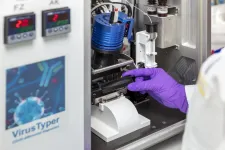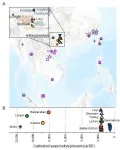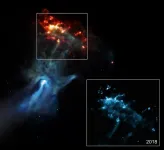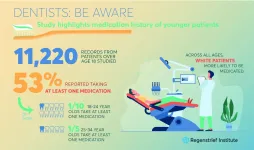Spreading of infections = need for collaboration between biology and physics
2021-06-24
(Press-News.org) Researchers at the Niels Bohr Institute, University of Copenhagen, together with epidemiologist Lone Simonsen from Roskilde University form part of the panel advising the Danish government on how to tackle the different infection-spreading situations we have all seen unfold over the past year. Researchers have modelled the spread of infections under a variety of scenarios, and the Coronavirus has proven to not follow the older models of disease spreading. An increasingly varied picture of its behaviour and thus its impact on society has emerged. In several scientific articles, researchers have described the knowledge accrued to date, most recently around the concept of "superspreaders". It turns out that only approximately 10% of those infected account for roughly 80% of the spread of the infection. The results have been published in the scientific journal Proceedings of the National Academy of Sciences, PNAS.
Where does our knowledge of infections spreading stem from?
The data researchers use to" feed" and develop computer models comes from a wide range of different sources. The Danish municipalities have kept inventories of the spread of the infection, and this data has the advantage that it stems from units that are not overly large. There is a high degree of detail and this means that one can trace local development more clearly and thus construct parameters for superspreading, which Postdoc Julius Kirkegaard has contributed to. Contact tracing is another source of information. In that case, the focus is on localising and limiting the individual's transmission of the virus. The third source is slightly more complicated as it seeks to follow the chain of infections via the gene sequence of the virus.
Who are the superspreaders?
Regardless of which source researchers examine, the results deliver roughly the same: 10% of all those infected account for as much as 80% of the spread of the infection. It is therefore crucial, in relation to the spread of the virus to locate the so-called superspreaders and uncover how superspreading occurs. Researchers stress that, at the moment, we are not quite sure what constitutes a person as a superspreader. It may purely be down to personal, physiological characteristics. In addition, there are varying degrees of superspreading in the population, so it is not necessarily just one or the other. Some people simply spread the virus more than others and the variation from persons with almost no transmission to superspreaders is great.
How do researchers model a population of just under 6 million individuals?
Three basic categories are considered important when modelling the population's behaviour, when calculating a scenario for the spread of infection: 1. The family context, 2. Work context and 3. The random contexts people find themselves in - in other words, people in proximity on public transport, at leisure activities etc. The time factor in all three is crucial, as it takes time to infect other people. In terms of time, these three categories are somewhat identical when it comes to common diseases, but not a superpreader coronavirus variant.
But this is where the individual characteristics of the virus come into play: Superspreaders are quite different when handled in a computer model. Methods known from physics become important here, as it is necessary to model individuals and their contacts. Researchers have set up computer models both for scenarios with and without superspreaders, and it transpires that shutting down workspaces as well as sporting events, and public transport has the same effect when the model does not take superspreaders into account. But when we include superspreaders, there is a pronounced difference, and the shutdown of public events has a much greater effect.
Disease modelling faces new challenges and strong interdisciplinary collaboration
Diseases can behave very differently and it is therefore incredibly important to be both ready and capable of rapid change in relation to the development of new models that reflect the characteristics of different diseases as accurately as possible, if we hope to contain them. Professor Kim Sneppen explains:" The biological variation of different viruses is enormous. SARS-CoV-2 contains a special feature in that it is at its most contagious just before one develops symptoms. This is the exact opposite of an earlier disease that threatened to become a pandemic, namely SARS, which is mostly contagious after one displays symptoms. Viruses are extremely advanced machines that each find specific weak points to exploit. A new field of research is rapidly developing, which examines how viruses attack the cells in our body. COVID-19 has proven to lead to very different sickness progressions for different patients. In that senses, it behaves chaotically, as we say in physics.".
Ph.D. student Bjarke Frost Nielsen and Professor Kim Sneppen see a large open field of research within the collaboration between physics and biology. Gathering as much possible information about different viruses is crucial thus enabling physists to deploy this knowledge in mapping scenarios to respond to them.
The potential for research into the spread of infections is great
Bjarke Frost Nielsen says:" We need to create a toolbox that contains a wide variation in the way we tackle the spread of transmission, in our computer programs. This is the immediate perspective we can see in front of us, at the moment. Mathematical disease modelling has been around for almost 100 years, but unfortunately not a lot of headway has been made over that period. To put it bluntly, the same equations from the 1930's are still in use today. In relation to some diseases, they can be correct, but in relation to others they can be way off. This is where, as physicists, we have a completely different approach. There are numerous parameters, i.e., social dynamics and much more varied interactions between individuals that we can build our scenarios upon. This is badly needed, when we see the enormous variations in the different diseases".
INFORMATION:
[Attachments] See images for this press release:
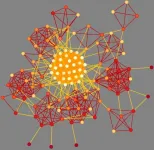
ELSE PRESS RELEASES FROM THIS DATE:
2021-06-24
During the continued progression of the Corona pandemic, rapid, inexpensive, and reliable tests will become increasingly important to determine whether people have the associated antibodies - either through infection or vaccination. Researchers at the Technical University of Munich (TUM) have now developed such a rapid antibody test. It provides the result in only eight minutes; the aim is to further reduce the process time to four minutes.
There are currently more than 20 different test procedures available for determining whether a person has antibodies against the new Corona virus. The waiting times for the results range between ten minutes and two and a half hours.
Matrix effects reduce the sensitivity of many of the methods. The more sensitive assays require numerous steps, ...
2021-06-24
While invasive zebra mussels consume small plant-like organisms called phytoplankton, Michigan State University researchers discovered during a long-term study that zebra mussels can actually increase Microcystis, a type of phytoplankton known as "blue-green algae" or cyanobacteria, that forms harmful floating blooms.
"Microcystis literally means small cell, but numerous cells cluster together in colonies that can float to the surface to form scums," said Orlando Sarnelle, a professor emeritus with the Department of Fisheries and Wildlife within the College of Agriculture and Natural Resources. "It is one of the most common causes of nuisance algal blooms in nutrient-enriched waters, including Lake ...
2021-06-24
When it comes to career aspirations for teenagers, a University of Houston psychology researcher believes it's best to shoot for the moon, so you can at least land in the stars. The truth is the moon may sometimes be unreachable.
In the Journal of Career Assessment, Kevin Hoff, assistant professor of psychology, reports the existence of important discrepancies between young people's dream jobs and employment realities.
"Almost 50% of adolescents aspired to investigative or artistic careers, which together account for only 8% of the U.S. labor market," reports Hoff, whose research examined the career aspirations of 3,367 adolescents (age 13-18 years) from 42 U.S. states. Investigative jobs include those in the field of science and research.
Hoff's team ...
2021-06-24
FORT LAUDERDALE/DAVIE, Fla. - We know that the domestic cat has distant relatives that roam the earth - lions, tigers, cheetahs and mountain lions. Less familiar are the 38 distinct species in the Family Felidae, many with strange names like pampas cat, kodkod and rusty spotted cat. The new field of genomics - the unravelling of DNA genomes of separate species - is resolving old conundrums and revealing new secrets across the history of evolutionarily related species among cats, dogs, bears and ourselves.
In the largest-ever study undertaken of Chinese cats, genetic detectives highlight the evolutionary uniqueness and premier conservation importance of the elusive Chinese mountain cat (Felis silvestris bieti), found only in the Tibetan ...
2021-06-24
A joint research team led by Prof. FU Qiaomei from the Institute of Vertebrate Paleontology and Paleoanthropology (IVPP) of the Chinese Academy of Sciences sequenced the ancient genomes of 31 individuals from southern East Asia, thus unveiling a missing piece of human prehistory.
The study was published in Cell on June 24.
Prof. FU's team used DNA capture techniques to retrieve ancient DNA from Guangxi and Fujian, two provincial-level regions in southern China. They sequenced genome-wide DNA from 31 individuals dating back 11,747 to 194 years ago. Of these, two date back to more than 10,000 years ago, making them the oldest ...
2021-06-24
This worm that lives in the White Sea is able to restore lost body segments. However, it turned out that suppression of FGF protein activity disturbs this ability. Similar proteins are found in humans. This discovery may lead to developing methods of fast wound healing. The research findings are published in the journal Genes as part of the project supported by the Russian Science Foundation.
Fibroblast growth factors (FGF) are proteins that play an important role in wound healing and tissue growth. When the need for regeneration of damaged body parts occur, FGFs are produced by epidermis, nervous tissue, macrophages and fibroblasts, which are the main cells of connective tissue. As a result, ...
2021-06-24
Adolescent marijuana use and binge drinking did not significantly change during the COVID-19 pandemic, despite record decreases in the substances' perceived availability, according to a survey of 12th graders in the United States. The study's findings, which appeared online on June 24, 2021, in Drug and Alcohol Dependence, challenge the idea that reducing adolescent use of drugs can be achieved solely by limiting their supply. The work was led by researchers at the University of Michigan, Ann Arbor, and funded by the National Institute on Drug Abuse (NIDA), part of the National Institutes of Health.
In contrast to consistent rates of marijuana and alcohol use, nicotine vaping in high school seniors ...
2021-06-24
Philadelphia, June 24, 2021 - After beginning treatment with remdesivir for COVID-19, a patient experienced significant bradycardia, or low heart rate. Her physicians used a dopamine infusion to stabilize her through the five-day course of remdesivir treatment, and her cardiac condition resolved itself at the end of the treatment. The case is discussed in Heart Rhythm Case Reports, an official journal of the Heart Rhythm Society, published by Elsevier.
"Remdesivir has become the standard of care for COVID-19 pneumonia and there is a paucity of data on its cardiac effects," explained lead author Jomel Patrick Jacinto, DO, HCA Healthcare/USF ...
2021-06-24
Motions of a remarkable cosmic structure have been measured for the first time, using NASA's Chandra X-ray Observatory. The blast wave and debris from an exploded star are seen moving away from the explosion site and colliding with a wall of surrounding gas.
Astronomers estimate that light from the supernova explosion reached Earth about 1,700 years ago, or when the Mayan empire was flourishing and the Jin dynasty ruled China. However, by cosmic standards the supernova remnant formed by the explosion, called MSH 15-52, is one of the youngest in the Milky Way galaxy. The explosion also created ...
2021-06-24
INDIANAPOLIS -- A new study demonstrates that many younger adult dental patients are taking medications and highlights the importance of dental providers reviewing medication histories regardless of age.
The study from Regenstrief Institute and the Indiana University School of Dentistry looked at dental records from 11,220 dental patients over the age of 18. The results showed:
53 percent of all patients reported taking at least one medication
12 percent of those age 18-24 were taking at least one medication
20 percent of those age 25-34 were taking at least one ...
LAST 30 PRESS RELEASES:
[Press-News.org] Spreading of infections = need for collaboration between biology and physics

